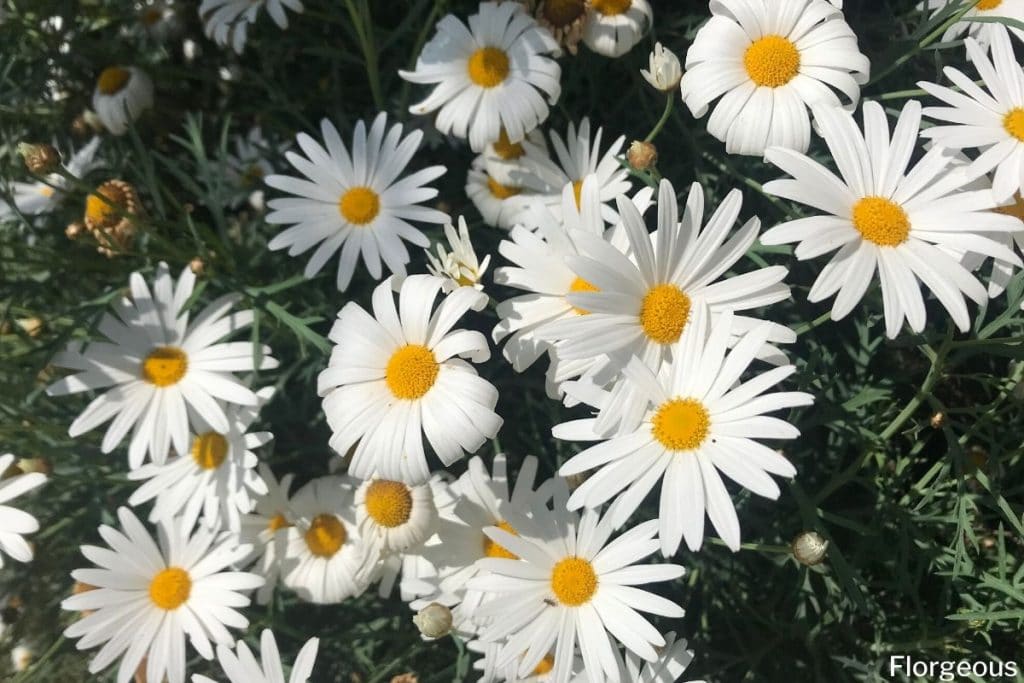In gardens and flower shops, one of the most common sightings is a daisy flower. Belonging in the Asteraceae or sunflower family, daisies are flowering plants native to North America, Europe, and Africa.
Daisy flowers got their name from an Anglo Saxon word daes eage that means “day’s eyes” and as a reference to how the flower opens at dawn and closes at night. They symbolize purity, innocence, motherhood, and new beginnings. These beautiful and diverse flowers further mean “loyal love” and “I will never tell.”
While most people are familiar with wild daisies or daisy varieties having white petals and bright yellow centers, there are, in fact, countless other different daisy flower types.
These perennial daisy types come in various shapes, sizes, and a multitude of colors. We’ve come up with a comprehensive list below about the most popular types of daisy flowers.
Common Daisies
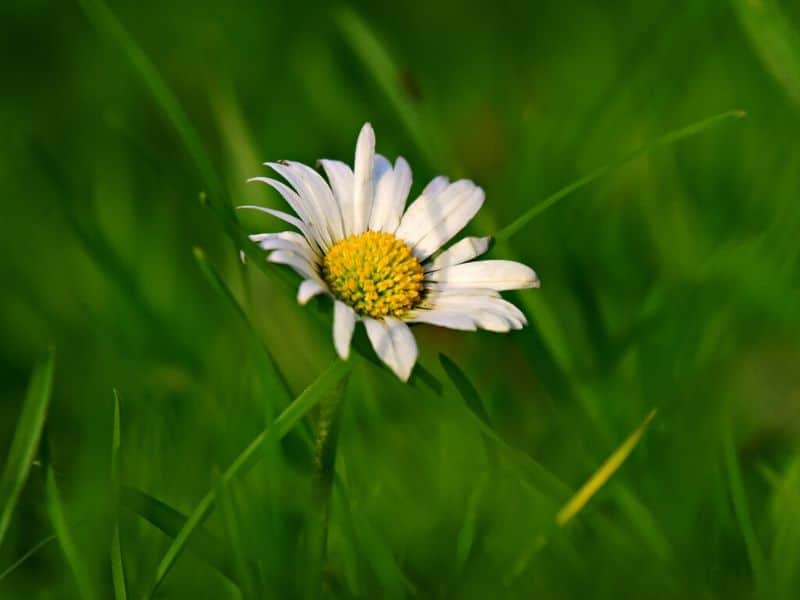
Perhaps the most popular type of daisies is the common daisy or also known for its scientific name Bellis perennis. Other common names of these plants include lawn daisy, English daisy, dog daisy, herb Margaret, Oxeye Daisy, bruisewort, and bairnwort (1).
The genus name Bellis means “pretty,” while the species name perennis means “through the years.” The Bellis genus has about 15 European and Mediterranean species (1).
Common Daisy: Plant Description
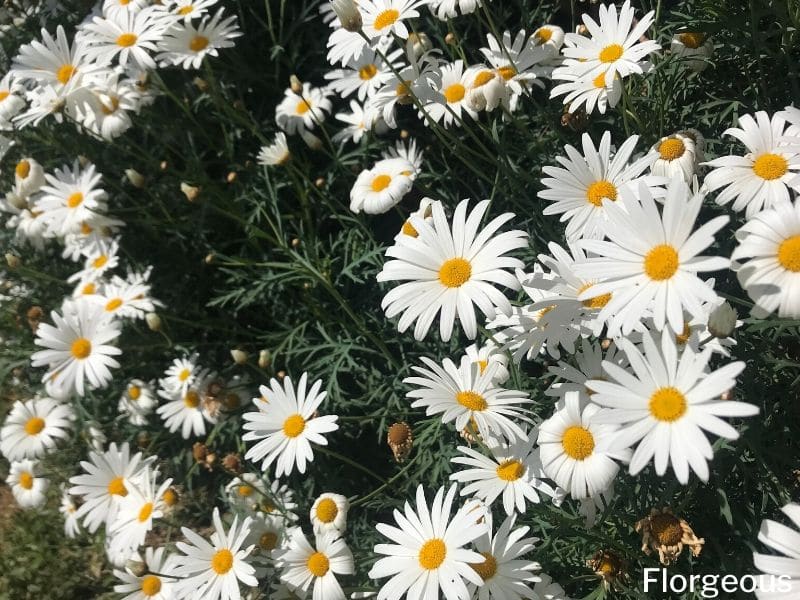
Characterized by their white and yellow blooms, the common daisy plants flaunt their beauty all year round. They are native to western, central, and northern parts of Europe, but have been naturalized in most warm regions across the globe.
The common daisy plant grows up to 10 cm in height. The leaves are blade oblanceolate or obovate (2) and form a rosette at the base of the plant. Emerging from the base are several stems with each stem holding a flower head.
The flower head comprises of yellow disk florets at the middle, surrounded by white ray petal-like florets. The ray florets are narrow and measure 7 to 10 mm (2). Flowers bloom in spring and summer (3).
Uses of Common Daisies
Although these plants have a tendency to be invasive and considered as weeds, common daisies or also known as English daisies, have long been valued for their medicinal uses.
The leaves are used as treatment against bruises, swellings, broken bones, wounds, and migraines, among others. A decoction of these plants, also, is used for rheumatism and bronchitis (1).
Recommended Varieties of Common Daisies
Modern plant breeders have developed varieties of common daisies with bigger flowers that measure up to 2 inches across. Colors available range from pink to salmon, pink, ruby, red, and more in semi-double to double petals. For some of these varieties, the signature yellow center of common daisies is almost lacking. Here are some of the most recognized common daisy cultivated varieties:
- Bellis perennis Habanera Mix
- Bellis perennis Bellissima Series
- Bellis perennis Tasso Mix
Gerbera Daisies
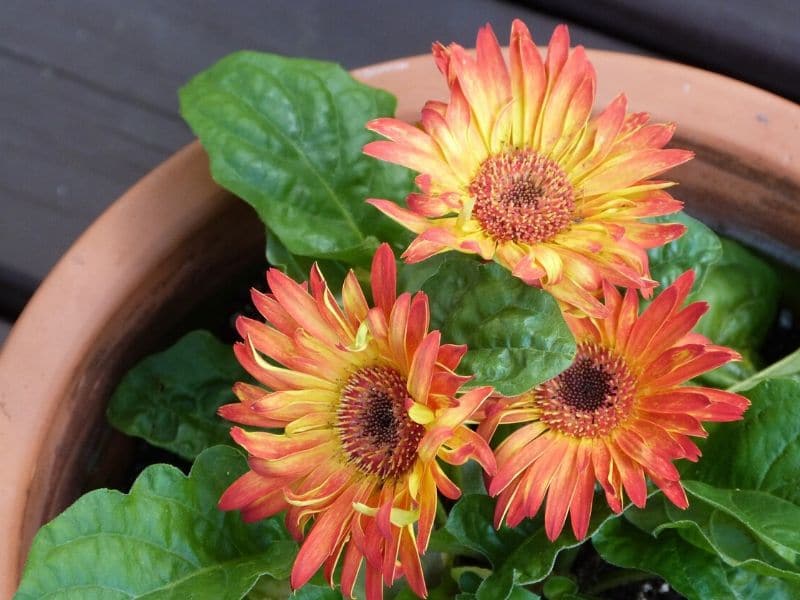
Gerbera daisies, a type of daisy flowers, are the fifth most popular cut flowers worldwide (4) after rose, chrysanthemum, tulip, and carnation. A classic florist-favorite alongside carnations and roses, these beautiful flowers can last from 2 to 3 weeks in a vase (5).
The common name gerbera refers to the entire Gerbera genus, which is comprised of more or less 30 known species. It was named after German doctor and botanist Traugott Gerber. These plants are native to South Africa, South America, and tropical Asia. Aside from being a popular cut flower, this type of daisy flowers is also grown in pots or containers for the garden.
Other known names of gerbera daisies are Transvaal daisy, Marguerite Daisy, African Daisy, and Barberton Daisy.
Gerbera Daisies: Plant Description
Gerbera daisy plants typically grow about 1 to 1.5 ft in height and spread up to 1 ft. They thrive well under full sun and can tolerate partial shade.
Flowers of gerbera daisies measure about 3 to 4 inches each. They come single or semi-double forms and in a plethora of bright colors, including yellow, red, pink, white, lavender, orange, and red (6). Each flower is comprised of outer ray florets, trans florets in the middle, and inner disk florets.
Uses of Gerbera Daisies
Gerbera daisies are ornamental plants commonly used as cut flowers for bouquets and other types of flower arrangements due to their striking and colorful flowers.
In landscaping, gerberas suit perennial planting beds and pots as they instantly add colors in garden design. Though perennial plants, some gardeners treat gerberas as annuals.
These flowers are also valued for their medicinal uses. Gerberas are used as a treatment against cough and cold, headache, mouth sores, and rheumatism.
Recommended Varieties of Gerbera Daisies
Gerbera flowers have always been an essential ornamental for commercial uses. With many species under this genus, the most popular cultivars are mostly hybrids between Gerbera jamesonii and Gerbera viridifolia, known as Gerbera hybrida. These famed hybrids offer a multitude of colors, forms, and sizes.
Here are some of the most recognized cultivars of gerbera flowers:
- Gerbera ‘Flori Line Maxi Lilac’
- Gerbera ‘Flori Line Maxi Mexican Pink’
- Gerbera ‘Flori Line Maxi Orange’
- Gerbera’ Garvinea Classic Jasmina’
- Gerbera’ Garvinea Lisa’
- Gerbera’ Garvinea Lydia’
- Gerbera’ Garvinea Sophie’
- Gerbera’ Garvinea Sweet Dreams’
- Gerbera’ Garvinea Sweet Honey’
- Gerbera jamesonii ‘Karoo’
- Gerbera jamesonii ‘Jaguar Pink’
- Gerbera jamesonii ‘Mega Revolution Orange Dark Eye’
- Gerbera jamesonii ‘Revolution Bicolor Rose’
- Gerbera jamesonii ‘Volcanoes’
Shasta Daisies
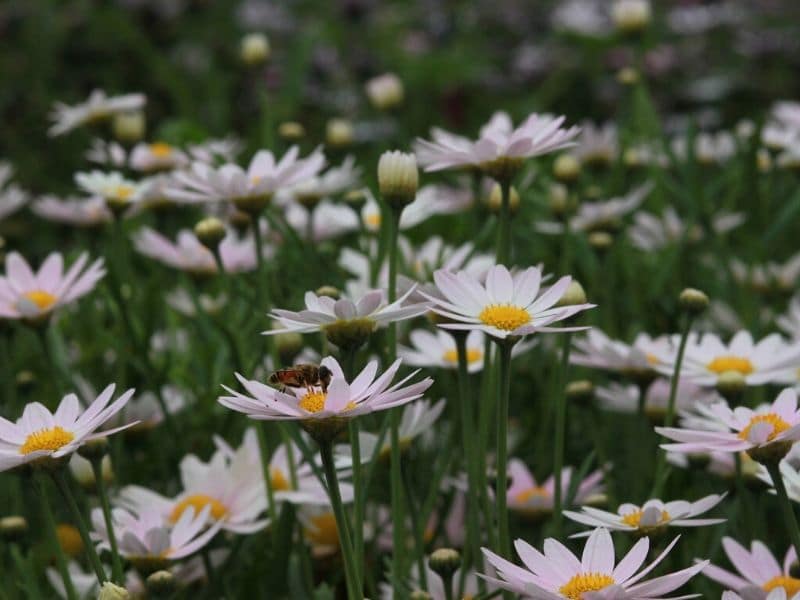
American horticulturist Luther Burbank developed Shasta Daisies or Leucanthemum × superbum from interbreeding wild species of chrysanthemums around the globe for 17 years (7). Burbank named these plants after the Mount Shasta in Northern California.
The genus name Leucanthemum came from the Greek words leucos (white) and anthos (flower), referring to the appearance of the flowers.
One of the many types of daisy, Shasta daisies are hardy, low-maintenance perennials that are native to Europe. Today, it has been naturalized throughout all regions of the United States (8). They thrive best if planted in full sun and fertile, moist, and well-drained soil. Flowering occurs in midsummer to fall.
Although Shasta daisies are generally low-maintenance, pests and diseases may occasionally cause problems. Examples of the most common pests and conditions of these plants are slugs, nematodes, aphids, earwigs, and leaf spots.
Shasta Daisies: Plant Description
Shasta daisy flowers are known for their all-white petals and golden yellow disk floret centers. The plants grow up to about 3 to 4 ft in height and spread up to 1 to 2 ft. The blooms typically reach 2 to 3 inches but can be up to 6 inches when fully matured (7). Flowering occurs in spring or early summer to early fall.
The leaves of these plants are glossy, dark green, and smooth. Over time, clumps will expand and need to be divided every two to three years.
Uses of Shasta Daisies
These flowers are commonly used as ground covers or border plants because of their beautiful foliage. They also make excellent cut flowers for bouquets and floral arrangements. When used as cut flowers, Shasta daisies last up to 10 days (7).
Recommended Varieties of Shasta Daisies
There are many cultivated varieties of Shasta daisies that are suitable for cut flowers. These include:
- Shasta Daisy’ Cobham Gold’
- Shasta Daisy’ Horace Red’
- Shasta Daisy’ Snow Lady’
- Shasta Daisy ‘Becky’
- Shasta Daisy’ Esther Red’
- Shasta Daisy’ Silver Princess’
- Shasta Daisy ‘T.E. Killin’
- Shasta Daisy ‘Tinkerbell’
- Shasta Daisy’ Wirral Pride’
- Shasta Daisy ‘Aglaia’
- Shasta Daisy ‘Fluffy’
Painted Daisies

Painted Daisies or Tanacetum coccineum are beautiful perennial plants that originated from southwestern Asia. They were previously classified as Chrysanthemum coccineum. These hardy perennial ornamentals require good drainage and 6 hours or more of direct sunlight a day but can tolerate partial shade as well (9).
The genus name Tanacetum originated from the Greek word athanatos, which means “immortal” or “long-lasting” and pertains to the plant’s flowers. The species name coccineum, on the other hand, originated from the Latin word coccineus, which means “scarlet” as a reference to the flower color of some painted daisy species.
This type of daisies can be propagated either by seeds or division. They can also be propagated from cuttings. Common pests and diseases of these plants include spider mites, aphids, botrytis, powdery mildew, thrips, and leafhoppers.
Other common names of these daisy plants include Pyrethrum, common Pyrethrum, Pyrethrum daisy, Persian pellitory, and Persian insect flower.
Painted Daisies: Plant Description
These plants form upright, bushy clumps that reach about 1 to 3 ft tall and 1.5 to 2 ft wide.
Tanacetum coccineum or painted daisies flaunt attractive single or double flowers that measure about 3 inches in diameter and available in multiple vivid colors, such as pink, yellow, red, violet, and white. The outer ray petals surround a golden yellow central disk. This plant from the daisy family blooms from early to midsummer.
What makes painted daisy flowers more attractive is their soft, finely textured, and fern-like foliage. Upper leaves are sessile and much shorter than the lower leaves. The leaves are incredibly aromatic and help repel insects
Uses of Painted Daisies
Painted daisy plants add summer and spring color in any garden if mass-planted or planted in groups. They also make excellent garden plants for borders and rock gardens.
Aside from their landscape use, painted daisies also make excellent cut flowers. They are frequently used in bouquets and floral arrangements for various occasions.
Also, the flowers are commercially cultivated to produce a natural insecticide called pyrethrins.
Recommended Varieties of Painted Daisies
Painted daisies have always been a popular cut flower and garden plant because of their showy flowers and equally attractive foliage. Here are some of the most common cultivars of these famed daisy type:
- Painted Daisy ‘Robinson’s Mixture’
- Painted Daisy ‘Robinson’s Red’
- Painted Daisy ‘James Kelway’
- Painted Daisy’ Mrs. James Kelway’
- Painted Daisy ‘Brenda’
- Painted Daisy ‘Eileen May Robinson’
- Painted Daisy’ Mont Blanc’
Purple Coneflower

Purple coneflowers or Echinacea purpurea are beautiful ornamentals that can be found in the eastern part of North America. They are formerly known as Rudbeckia purpurea.
These plants are herbaceous perennials that require full sun to partial shade and fertile soil. They can tolerate drought and heat once fully established (10).
The genus name Echinacea comes from the Greek word echinos, which means “hedgehog” or “sea urchin” as a reference to the spikes in the center of each flower. Among the many species under the Echinacea genus, the E. purpurea or purple coneflowers are the most popular and readily available.
These plants can be propagated by root cuttings, seeds, or division. Purple coneflowers can be divided every 3 to 4 years. Common pests and diseases of these plants include Japanese beetles, leaf spots, and aster yellow disease.
Other common names of this plant are Eastern Purple Coneflower and Purple Rudbeckia.
Purple Coneflowers: Plant Description
Purple coneflowers have an upright habit. The plants grow up to about 4 feet in height and spread up to more or less 30 inches. Like other species in the Echinacea genus, purple coneflowers have dark green, lanceolate leaves that measure about 4 to 8 inches long. Upper leaves are smaller and narrower (11).
The flowers display a brown central cone of disk flowers and ray petals in varying colors, which can be pink, purple, yellow, or white, depending on the variety. Flower size ranges from 3 to 6 inches. Flowering occurs in summer and spring.
The stems are hairy or pubescent and not aromatic. They are light green with small purple streaks.
Uses of Purple Coneflowers
Purple coneflowers are valued for their medicinal purposes. They are used in many herbal remedies and other types of medicine as treatments against cough, common colds, fever, bronchitis, urinary tract infections, mouth inflammation, wounds, and burns (10). The roots are utilized as a treatment for snakebites, rabies, skin ailments, and other diseases.
In landscaping, purple coneflowers look great in mass plantings for perennial beds. They attract butterflies and many types of birds, which make them ideal additions in a butterfly garden.
Recommended Varieties of Purple Coneflowers
Here are the most popular cultivated varieties of purple coneflowers:
- Purple coneflowers ‘Magnus’
- Purple coneflowers’ Ruby Star’
- Purple coneflowers’ White Swan’
- Purple coneflowers’ Bright Sky Sunrise’
- Purple coneflowers’ Bright Sky Summer Sky’
- Purple coneflowers’ Kim’s Knee High’
- Purple coneflowers’ Merlot’
- Purple coneflowers’ Bravado’
- Purple coneflowers’ Bright Star’
- Purple coneflowers’ Tiki Torch’
- Purple coneflowers’ Pink Double Delight’
Gloriosa Daisies
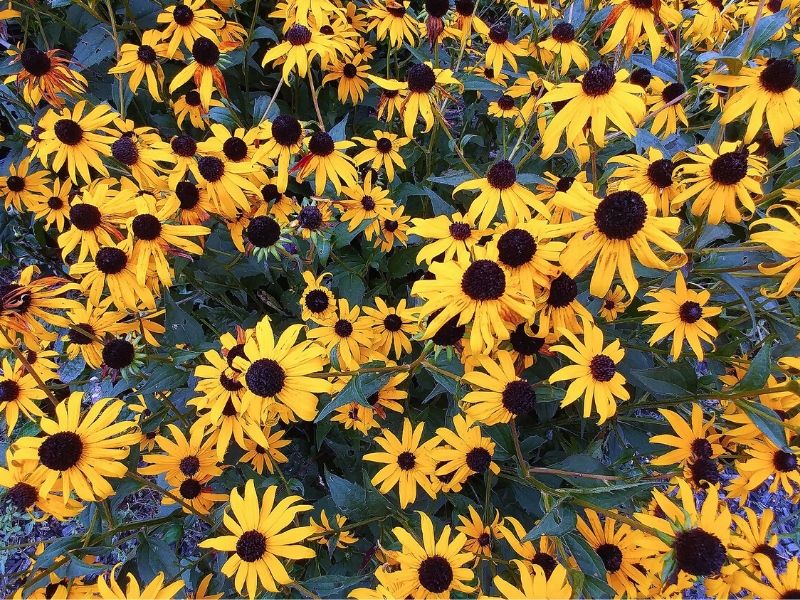
Gloriosa daisies, otherwise known as black-eyed Susans or Rudbeckia hirta, are annuals or short-lived perennials with an upright habit (12). They originated from Eastern and Central North America. Despite its common name, gloriosa daisy wildflowers aren’t true daisies. Some people might even call it yellow daisy.
The name hirta comes from a Latin word that translates to “hairy,” referring to the soft hairs on the plant’s leaves and stems.
These plants can be propagated by seeds, which take 7 to 14 days to germinate. They can also be reproduced by division.
Gloriosa daisies thrive best if planted in full sun and average soil. Fully established plants can tolerate drought, though providing sufficient water and fertilizer would result in more and bigger blooms. Common pests and diseases of these plants include aster yellow, powdery mildew, bacterial leaf spot, smut, rust, aphids, slugs, and snails.
Aside from being known as gloriosa daisies and black-eyed Susans, Rudbeckia hirta plants are also referred to as orange coneflower and rudbeckia.
Gloriosa Daisies: Plant Description
These easy to grow perennials grow up to about 2 to 3 feet tall on long, slightly hairy stems.
The flowers can be double or semi-double in varying colors, depending on the variety. Available colors for these daisy-like flowers are yellow, rust, and gold with a dark brown center. Each flower with yellow petals measures about 5 to 9 inches in diameter and blooms throughout the summer.
The leaves of these plants are lance-shaped and measure about 2 to 4 inches long. Leaf margins are smooth but may have slight serration. The upper leaves are smaller and narrower than the lower leaves.
Uses of Gloriosa Daisies
Gloriosa daisies are one of the easiest garden plants to grow. Plant them as borders or in masses to maximize their beautiful and colorful blooms that attract butterflies and hummingbirds. They also do great in containers.
These plants are also cultivated for cut flower uses. They make excellent flowers for bouquets and vases, with a vase life of 7 to 14 days (12).
Black-Eyed Susans are the official floral emblem of the state of Maryland.
Recommended Varieties of Gloriosa Daisies
Gloriosa daisies or black-eyed Susans are widely cultivated around the globe for their attractive flowers. Currently, there have been lots of cultivars developed, with some of them gaining the Royal Horticultural Society’s Award of Garden Merit. Some of the most popular gloriosa daisy cultivars include:
- Gloriosa Daisy’ Indian Summer’
- Gloriosa Daisy ‘Toto’
- Gloriosa Daisy’ Double Gold’
- Gloriosa Daisy ‘Marmalade’
- Gloriosa Daisy’ Irish Eyes’
- Gloriosa Daisy’ Becky Mixed’
- Gloriosa Daisy ‘Chim Chinese’
- Gloriosa Daisy ‘Goldilocks’
- Gloriosa Daisy’ Rustic Dwarfs Mixed’
Daisy is just one of many flower names that you can explore. Don’t forget to check our other posts for more amazing plants.
FAQs
Is chamomile a daisy?
Chamomile is technically considered a daisy! Both belong to the same large botanical family, Asteraceae, sharing the classic daisy-like structure with white petals and a yellow center. However, chamomile flowers are typically smaller and have single-layered petals compared to many true daisies.
Are there rainbow daisies?
While there is no natural variety of daisy that displays the full spectrum of colors like a rainbow, there are cultivated varieties and hybrids that come in a range of colors, creating a vibrant and colorful appearance. These cultivated daisies can showcase various hues, but they do not exhibit the full spectrum of a traditional rainbow.
Up Next: Daisy Flower Meaning and Symbolism
References
Reference List:
- Ucanr.edu. (2020). [online] Available at: https://ucanr.edu/repository/fileaccess.cfm?article=167428&p=SCTLMT
- Ucjeps.berkeley.edu. (2020). Bellis perennis. [online] Available at: https://ucjeps.berkeley.edu/eflora/eflora_display.php?tid=1652
- Plants.ces.ncsu.edu. (2020). Bellis perennis (Bairnwort, Banwood, Banwort, Benner Gowan, Bone Flower, Bonewort, Bruisewort, Common Gowan, Dog Daisy, Double Daisy, English Daisy, Goose Flower, Gowlan, Herb Margaret, Lawn Daisy, Lockin Gowan, Luckin Gowan, Marguerite, May Gowan, Noon Flower, True Daisy, Woundwort) | North Carolina Extension Gardener Plant Toolbox. [online] Available at: https://plants.ces.ncsu.edu/plants/bellis-perennis/
- Compgenomics.ucdavis.edu. (2020). COMPOSITAE. [online] Available at: https://compgenomics.ucdavis.edu/compositae_data.php?name=Gerbera+hybrida
- Ndsu.edu. (2020). Gerbera Daisies. [online] Available at: https://www.ndsu.edu/pubweb/chiwonlee/plsc211/student%20papers/articles03/carly.bye/gerberadaisy.htm
- Gardeningsolutions.ifas.ufl.edu. (2020). Gerbera Daisy – University of Florida, Institute of Food and Agricultural Sciences. [online] Available at: https://gardeningsolutions.ifas.ufl.edu/plants/ornamentals/gerbera-daisy.html
- Ndsu.edu. (2020). Shasta Daisies. [online] Available at: https://www.ndsu.edu/pubweb/chiwonlee/plsc211/student%20papers/articles01/mzick/mzick.htm
- Aggie-horticulture.tamu.edu. (2020). Shasta Daisy. [online] Available at: https://aggie-horticulture.tamu.edu/wildseed/36/36.7.html
- Plants.ces.ncsu.edu. (2020). Tanacetum coccineum subsp. coccineum (Painted Daisy, Pyrethrum) | North Carolina Extension Gardener Plant Toolbox. [online] Available at: https://plants.ces.ncsu.edu/plants/tanacetum-coccineum-subsp-coccineum/
- Bookstore.ksre.ksu.edu. (2020). [online] Available at: https://bookstore.ksre.ksu.edu/pubs/mf2624.pdf
- Davenport, M. (1999). Echinacea. [online] Home & Garden Information Center | Clemson University, South Carolina. Available at: https://hgic.clemson.edu/factsheet/echinacea/
- Aggie-horticulture.tamu.edu. (2020). Gloriosa Daisy. [online] Available at: https://aggie-horticulture.tamu.edu/wildseed/gloriosadaisy.html
Close

